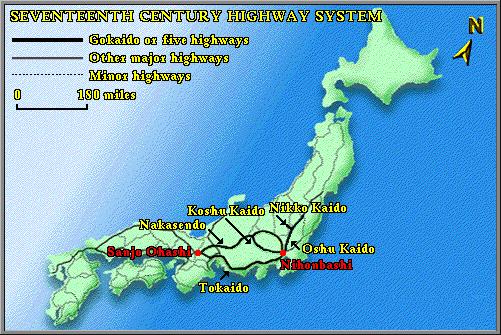
17th century Highway System
In the 17th century, the Edo shogunate authorities placed strong emphasis on revitalizing the highway system to ensure that orders and messages could be relayed quickly, efficiently, and safely between Edo and the provinces. This was essential for effective government. Among the many different types of travelers regularly seen along the ‘Five Roads’ were runners, usually traveling in pairs. One would carry a small box on the end of a short pole, slung over his shoulder. The other would carry a pole with a paper lantern hanging from it, inscribed with the characters goyo, meaning ‘official business’. Moving extremely quickly, it was the job of the lantern bearer to move people out of the way, to ensure uninterrupted passage for his colleague. It was he, the box bearer, who was entrusted with ensuring the contents of the box – an official letter to or from the shogun’s court – arrived at its destination in the shortest time possible. Working in relays, through night and day, such a message could be taken from Kyoto to Edo, a distance of more than 300 miles, in as little as 40 hours.
At the beginning of the Edo period, official messengers traveled on horseback – a form of ‘pony-express’ – but later the express runner system was preferred. The runners, known as hikyaku, or ‘flying feet’, were proud of their profession and trained hard by tying weights to their backs, which dragged on the ground behind them as they practiced running. The ‘flying feet’ were naturally competitive and would sometimes race each other. Claims to the first ‘Marathon’ run in Japan have their origins in such a race, between Usui-toge and Annaka post-town on the Nakasendo. This race is still commemorated by an annual run today.

Usui-toge
In 1663 the shogunate granted permission for a private association to be formed, to carry ‘non-official’ express mail. The usual arrangement was for mail to be dispatched from companies in Edo, Kyoto or Osaka on fixed dates, three times a month. Working a tight, fixed schedule the messengers, who wore happi-coats bearing the insignia of their company, would make the journey from Kyoto to Edo in eight days for ‘average express’ items and, for a higher fee, in five or six days for the ‘fast express’. Many trucking and delivery companies in Japan today trace their origins to this time.

